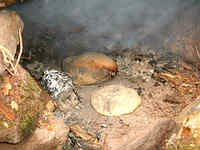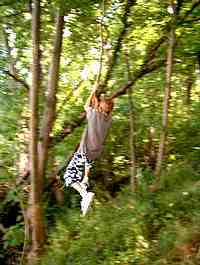source: www.youthwork-practice.com | 2000 Games, Devotions, Themes, Ideas and more for Youth Work
only for private using
Adventurer and settler’s camp
In this collection of games, you will find ideas for knight games, pirate games, red-Indian games and stone-age camps. Why not try out an outdoor survival or settler’ day? In principle, with a little fantasy and imagination, everything is possible.
Adventurer tournament
-
Archery
A target is shot at with a bow and arrow. Important when doing archery: all spectators and group leaders must stand behind the archer. The archery area should only be entered once all arrows have been shot. Watch out that no windows, streets or paths are behind the target.
-
Hatchet/axe throwing
An axe is thrown at an upright wooden board or block of wood. It must be thrown so that the axe sticks into the wood. In no circumstances should you use a living tree as a target. No spectators should stand nearby when an axe is thrown. There is always the danger that an axe will rebound and hit someone. Nobody should stand behind the thrower, as the axe could slip out of his hands and injure someone. Option: Instead of using a real axe/hatchet, you could make one out of wood and throw it at tin cans or water balloons hanging from a tree or fixed onto a wooden board.
-
Javelin
A javelin is thrown into a marked out circle. Different points are awarded depending on where the spear lands.
Option: The game becomes slightly more difficult, if the javelin must be thrown through a tyre which is hanging from a tree.
Option: A water balloon is the target.
Option: The javelin must be thrown as far as possible.
-
Lasso throwing
The lasso thrower must lasso a vertically standing post or log which is at a distance of approx. 4-5 metres.
-
Sneaking up
The group leader is blindfolded. The players must look for objects and take them away without being caught by the leader. This should take place in an area 5x5m or in a room. The time limit is 2 minutes and a second member of staff should be present to keep everything under control.
Option: The group leader sits on the floor with the legs spread out to the side. Between his legs are a stone and a tin can with a stone on top. A player tries to take all 3 items without being noticed. The group leader is only allowed to reach out 5 times and player has 2 minutes to steal the items.
Adventurers-relay race
-
Chariot race with team change.
The game is similar to a Roman chariot race. There is one rider and one horse (wheel barrow). Once the relay is completed, it is the other rider’s turn. Option: Two pairs set off together. The riders must swap over during the race.
-
Tree trunk pull.
A (not too) heavy tree trunk must be pulled along a relay race course. Then it is the next players turn.
-
Artistic riding
A couple (on piggy back) must run through an obstacle course and try to knock over various objects with a lance (skittles, balloons etc.). At the end, they must pick up a ribbon with the lance and bring it back. The couple take turn to complete the course.
-
Sense of direction
The relay runners must run towards his team member on the other side of the course while blindfolded. He must tag his partner and then tie the blindfold around his partner’s eyes. The partner who is not blindfolded may shout out instructions. This game may result in kids bumping into each other. The players should be instructed to place their hands out in front of them to feel the way.
Station games
-
Tree climbing
Different instructions/information are hidden in a tree (small cards stuck in place with pins) which the player can only reach and read by climbing the tree. You should make sure that the tree is relatively easy to climb. It might be sufficient that the kids only climb onto the first branch.
-
Sawing a tree trunk
The player must cut a cross section from a tree trunk by using a saw. How long will the individual players need to complete the task?
-
Swinging like Tarzan
A rope is tied to an overhanging strong branch. The player must use the rope to swing himself onto/or touch a specific target (table, podium, tree etc.) It is then the next player’s turn. This game is totally dependent on the area available and cannot always be carried out.
-
Horseshoe throwing
A horseshoe must be thrown onto a stick or tent peg which is fixed into the ground from a distance of approx 2. metres. Each player has 3 (10!) throws.
-
Find path finder signs
The scout path signs which have been learnt (path finder signs) can now be put into practice. Those who have paid attention can find treasure or a clue how to reach the next station. Die Path finder signs can also be used throughout the game to mark the way. However, you should watch out that the signs/directions have not been manipulated or changed by other groups. A member of should go with the kids for safety reasons.
-
Washing gold
For this station, small pebbles should be sprayed beforehand with gold spray-paint. You should spray approx 10-20 pebbles per group which are then hidden/thrown in stream bed. The group must now try to locate the gold pebbles within a specific amount of time in their „pan“. One point is awarded for each pebble found. Dependent upon the level of difficulty required, they pebbles can also be buried into the Bach bed. You should be aware of any nature protection laws when playing this game. A running stream, or an area which is under nature protection laws should not be chosen for this game, so that you do not disturb the river embankment and plant world (in and out of the water). If this is not possible in your area, a sandpit can be used to hide the gold. The pebbles can surely be found with a sieve and water. If the pebbles have been dirtied by sand or earth, you can only find out if the pebbles are really gold pieces by using water to clean them.
-
Flask rally
A flask hanging on a belt is filled with water. The player runs with the bottle to a bucket and empties the bottle into the bucket (without freeing the flask from the belt – he might get a little bit wet) and then runs back to fill the bottle up again. A harder version of the game is if the water can only be filled by diving into the water. The player must therefore enter the water at least up to the belly, so that the bottle (flask) can be pushed underwater and be filled. This option only works in summer with a bathing suit.
-
Tying knots
The group leader demonstrates how to tie a specific knot. The players must try to copy the knot.
-
Sneaking and crawling through the outdoors
The group must cover an area of land by crawling (within a specific amount of time) without touching the tightened ropes, „tin cans“or „small bells“. This station can also be made a little more interesting by leading the course through puddles or swampland.
-
Spy
Various objects are hidden or hung in a tree. The task is to recognise as many objects as possible at a distance of 20-30m within 2 minutes.
-
Orientation
The player must try to remember the positions of different targets. The player is then blindfolded and must bring an object or several objects to the specific target areas. Options and help: the other members of the group may shout out instructions and directions.
-
Knowledge
The ability to recognise different trees and plants, to know all about nature, to recognise animal tracks and different animal types, as well as knot tying and orientation, is necessary for the safety and survival of a real settler or adventurer. Every settler should know the secret path markings with the help of the path finder signs. The illustrations presented here, should help improve your knowledge and help you answer the quiz questions on a quiz station.
-
Outdoor adventure game
An outdoor adventure game should not be missing from any adventurer and settler’s camp. If the different components of the games are combined, and if the game is split into sections, the game can go on for 1-2 days – depending on the weather of course. Points can be awarded for each game component. At the end of the day/game, the best settler and adventurer (or best group) can be presented. The following game components are possible:

- Look for the best camp spot and set up camp
- Build an earth oven
- Search for signs leading to provisions or hidden matches.
- Cook a meal (Sausage, flour, eggs, carrots, potatoes, butter)
- Light a fire by rubbing sticks, with a magnifying glass or tersely with matches.
- Go on a hunt (Catching, sneaking and searching games) with a fur hunt
- Search for gold and swap it for food or furs
- Swap furs for food or money/gold
- Find/swap messages and perform tasks and earn food/gold etc.
- A tournament with prizes.

Outfit
Adventurers and settlers usually wore fur coats or leather jackets (with long fringes), trousers made from leather or heavy material, leather shoes, boots or moccasins. The Indian adventurer sometimes only wore a leather skirt (loin cloth). Their equipment was made up of a long knife, an axe, a weapon or a bow and arrow to go on the hunt, a leather/linen bag and a lasso. A hat is also a requirement. All in all, it is not impossible to find a suitable outfit for the kids.
-
Head wear
Each player should bring an old leather hat with them or sew a settler’s hat together from leftover pieces of fur.
-
Trousers
Each player should bring an old worn out pair of jeans with them. Alternatively they can make a pair of trousers or an apron with left over pieces of leather. However, if they decide on the leather loin cloth, the rest of the outfit must then be made into an Indian style outfit. A loin cloth is made from a section of leather on the front and the same to cover the bottom. Suitable materials are one coloured pieces of material, hemp sacks etc. Both halves should be approx 20-30cm wide (depending on the width of the hips) and 40cm long. The material should be folded over at the top and sewn down. A belt or piece of cord can now be pushed through. A fringe can be cut into the bottom of the material. To complete the loin cloth, some Indian motives can be painted on it or printed with a potato stamp.
-
Shoes
Old leather boots are suitable (if the players have some). Otherwise some moccasins could also be produced with a bit of creativity and if enough leather is available. A pair of old Wellington boots or shoes can also be decorated with pieces of fur. That is quicker and they definitely fit.
-
Shirt or jacket
Each member of the group should bring an old denim jacket or old leather jacket with them. A leather jacket with a fringe would be even better. If the weather is too warm, a single coloured shirt is probably better. If someone is creative, they might be able to produce their own jacket from left over pieces of leather or fur. You could also take an old denim jacket or pullover and sew some fur onto it.
Note: Furs and leathers are not exactly cheap and therefore should be used in a sensible and responsible way. If the players want to represent an Indian settler, they can simply take an old, long t-shirt and cut a fringe into the bottom. A simple and cheap way to achieve the desired look.

Weapons
-
Knife
A long outdoor knife can quickly be cut from a piece of wood, cut from a 10-15mm deep piece of plywood or particle board. With the help of a stencil, the required shape is cut out with a fretsaw or jigsaw. The edges should be smoothed with sand paper/wood file and formed into the desired shape. Warning: The decision to send kids into the woods with a real knife should be seriously thought over. The decision is surely dependent on the age of the kids.
-
Hatchet, axe or spear
A hatchet, axe or spear can also be made from plywood and wooden handle. The hatchet or spear tips are made from plywood and attached to a brush handle or twig with sting or raffia. With feathers, cuts or painted designs, the axe or spear can be nicely decorated.
-
Bow and arrow
Producing a bow and arrow should pose no problem. Twigs which are approx 15mm wide are suitable, however is dependent upon how large the bow should be. A small slit is cut into the wood at the top and bottom. A plastic string (approx 2mm nylon) is attached to both ends and tensed so that the ends of the branches are shaped into a bow. The bow and arrows can be decorated with small feathers. Corks which are attached to the arrows with sticky tape are suitable as arrow tips.
Warning: Do not allow the group members to shoot at each other or at the tents. A higher level of supervision and explanation of the rules is required. If a player does not follow the rules, he must give up his weapon. If lots of small children are in the camp, maybe the bow and arrow should be left out.
[ © www.youthwork-practice.com | 2000 Games and Ideas for Youth Work ]






